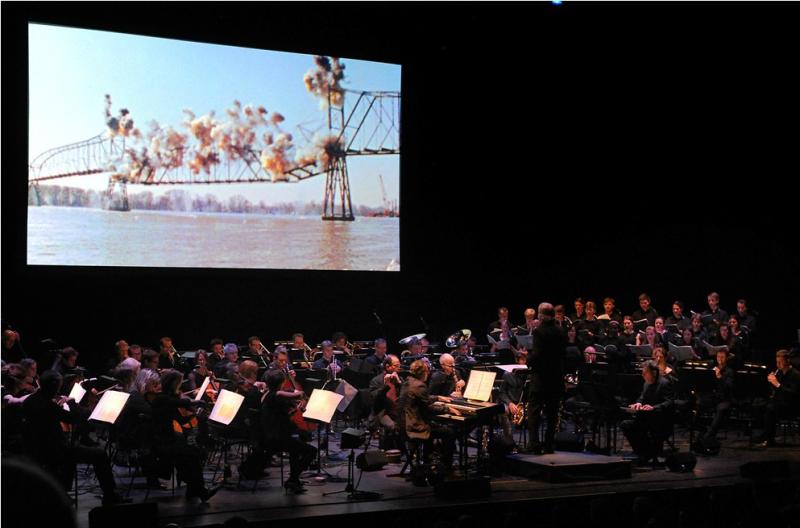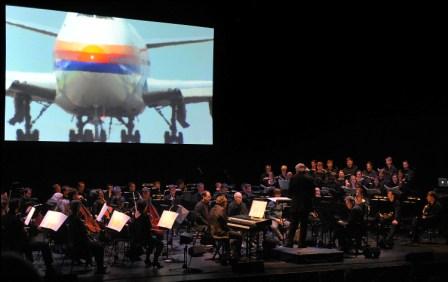Philip Glass, Koyaanisqatsi, Barbican Hall | reviews, news & interviews
Philip Glass, Koyaanisqatsi, Barbican Hall
Philip Glass, Koyaanisqatsi, Barbican Hall
Live music version of eco film classic is hugely impressive after shaky start

Philip Glass is sufficiently famous that his 75th Birthday celebrations have been going on all year (he was actually 75 in January) and the year saw two of the absolute highlights of his career presented at the Barbican. His first opera Einstein On The Beach and last night, the soundtrack to his first film score Koyaanisqatsi, performed alongside the film itself, with Glass on keyboards.
There will be those who remain implacably opposed to what they see as his facile repetitive argeggios and are inclined to dismiss everything Glass has done. For the rest of us, Einstein and Koyaanisqaatsi represent Glass at his best, after the slightly wearing initial hard core systems music of the early 1970s and before the bombastic maximalism of some of his later operas.
 In fact, the wordless film directed by Godfrey Reggio and released in 1982 is a perfect match for Glass’s music. Koyaanisqaatsi was ground-breaking not just for the balance of images and music, but for its eco-friendly message – 1982 was early days for the newly dubbed “green” politics. It was also hugely innovative in its use of time-lapse photography, a technique which was stunning at the time, but whose effect has been diluted by use in myriad adverts. It's also become a stoner late night film classic. Other things you wouldn’t have noticed 30 years ago have a distancing effect – did people really have haircuts like that?
In fact, the wordless film directed by Godfrey Reggio and released in 1982 is a perfect match for Glass’s music. Koyaanisqaatsi was ground-breaking not just for the balance of images and music, but for its eco-friendly message – 1982 was early days for the newly dubbed “green” politics. It was also hugely innovative in its use of time-lapse photography, a technique which was stunning at the time, but whose effect has been diluted by use in myriad adverts. It's also become a stoner late night film classic. Other things you wouldn’t have noticed 30 years ago have a distancing effect – did people really have haircuts like that?
This was a newly expanded version of the score with the Britten Sinfonia and Trinity Laban Chamber Choir joining the Philip Glass Ensemble with Glass’s long-time musical cohort Michael Riesman as conductor. (The Glass Ensemble have played alongside the film, at the Brighton Festival for example, a couple of years back).The start of the film, with shots of majestic New Mexico nature, features appropriately slow, meditative music. The music should be as implacable as the images of the giant rock formations, but last night got off to a shaky start. The sound balance took some time to get right, and the co-ordination between the different musical groups was not entirely aligned, while the bass singing of the word Koyaanisqatisi (Hopi Indian for “Life out of balance”) by Jeremy Birchall seemed initially tentative (unless this was a deliberate comment on how the earth is even more vulnerable than it was 30 years ago).
It was like beings from another planet were observing ours, with sadness at our destructive power but with some compassion and wry amusement too
But the musical express got up to speed once the first humans appeared, after about 20 minutes, with mining operations, a nuclear detonation, sunbathers on the beach with a power plant in the background. Then we were in urban chaos with the famous speeded up footage of traffic and a huge moon behind a skyscraper. After focusing on individuals (those haircuts!), and assembly lines, the film panned back with the white and red rushing lights of traffic at night like a post-Mondrian abstract work of art. Parts of the film, like the video games and microchips that looked like a city from afar worked like a pop video (Madonna’s “Ray Of Light” video was among many that have been influenced by the film).
Although the film and music ended gloomily with the explosion of a rocket in mid-sky in eerie slow motion (as a symbol of humanity's technological hubris) and quotes from Hopi sages like “If we dig precious things from the land, we invite disaster” and the return of the Koyaanisqatsi chant, this time with the choir, the frenetic energy of the film and music was more exhilarating than depressing. Its eco message was delivered elegantly and eloquently, with enough mystery to transcend mere propaganda.
The distancing effects of the different film speeds and the headlong momentum of the music made it feel like beings from another planet were observing ours, with sadness at our destructive power, but with some compassion and wry amusement too. Koyaansqatsi had two follow-up films by the same team, but the first one packs the most visual punch. It is highly effective musically, in terms of melody, propulsive rhythm and at times magical empathy with Reggio’s images.
The brass, strings, two keyboards (with Mick Rossi playing the fast bits) and choir added a real depth and power to the experience. The whole was bigger than the parts, with queues for returns reflecting the fact that this was an Event, rather than a mere concert.
Watch trailer for Koyaanisqatsi
rating
Explore topics
Share this article
Add comment
The future of Arts Journalism
You can stop theartsdesk.com closing!
We urgently need financing to survive. Our fundraising drive has thus far raised £49,000 but we need to reach £100,000 or we will be forced to close. Please contribute here: https://gofund.me/c3f6033d
And if you can forward this information to anyone who might assist, we’d be grateful.

Subscribe to theartsdesk.com
Thank you for continuing to read our work on theartsdesk.com. For unlimited access to every article in its entirety, including our archive of more than 15,000 pieces, we're asking for £5 per month or £40 per year. We feel it's a very good deal, and hope you do too.
To take a subscription now simply click here.
And if you're looking for that extra gift for a friend or family member, why not treat them to a theartsdesk.com gift subscription?
more Classical music
 Hallé John Adams festival, Bridgewater Hall / RNCM, Manchester review - standing ovations for today's music
From 1980 to 2025 with the West Coast’s pied piper and his eager following
Hallé John Adams festival, Bridgewater Hall / RNCM, Manchester review - standing ovations for today's music
From 1980 to 2025 with the West Coast’s pied piper and his eager following
 Kaploukhii, Greenwich Chamber Orchestra, Cutts, St James's Piccadilly review - promising young pianist
A robust and assertive Beethoven concerto suggests a player to follow
Kaploukhii, Greenwich Chamber Orchestra, Cutts, St James's Piccadilly review - promising young pianist
A robust and assertive Beethoven concerto suggests a player to follow
 Robin Holloway: Music's Odyssey review - lessons in composition
Broad and idiosyncratic survey of classical music is insightful but slightly indigestible
Robin Holloway: Music's Odyssey review - lessons in composition
Broad and idiosyncratic survey of classical music is insightful but slightly indigestible
 Classical CDs: Wolf-pelts, clowns and social realism
British ballet scores, 19th century cello works and contemporary piano etudes
Classical CDs: Wolf-pelts, clowns and social realism
British ballet scores, 19th century cello works and contemporary piano etudes
 Bizet in 150th anniversary year: rich and rare French offerings from Palazzetto Bru Zane
Specialists in French romantic music unveil a treasure trove both live and on disc
Bizet in 150th anniversary year: rich and rare French offerings from Palazzetto Bru Zane
Specialists in French romantic music unveil a treasure trove both live and on disc
 Scottish Chamber Orchestra, Ibragimova, Queen’s Hall, Edinburgh review - rarities, novelties and drumrolls
A pity the SCO didn't pick a better showcase for a shining guest artist
Scottish Chamber Orchestra, Ibragimova, Queen’s Hall, Edinburgh review - rarities, novelties and drumrolls
A pity the SCO didn't pick a better showcase for a shining guest artist
 Kilsby, Parkes, Sinfonia of London, Wilson, Barbican review - string things zing and sing in expert hands
British masterpieces for strings plus other-worldly tenor and horn - and a muscular rarity
Kilsby, Parkes, Sinfonia of London, Wilson, Barbican review - string things zing and sing in expert hands
British masterpieces for strings plus other-worldly tenor and horn - and a muscular rarity
 From Historical to Hip-Hop, Classically Black Music Festival, Kings Place review - a cluster of impressive stars for the future
From quasi-Mozartian elegance to the gritty humour of a kitchen inspection
From Historical to Hip-Hop, Classically Black Music Festival, Kings Place review - a cluster of impressive stars for the future
From quasi-Mozartian elegance to the gritty humour of a kitchen inspection
 Shibe, LSO, Adès, Barbican review - gaudy and glorious new music alongside serene Sibelius
Adès’s passion makes persuasive case for the music he loves, both new and old
Shibe, LSO, Adès, Barbican review - gaudy and glorious new music alongside serene Sibelius
Adès’s passion makes persuasive case for the music he loves, both new and old
 Anja Mittermüller, Richard Fu, Wigmore Hall review - a glorious hall debut
The Austrian mezzo shines - at the age of 22
Anja Mittermüller, Richard Fu, Wigmore Hall review - a glorious hall debut
The Austrian mezzo shines - at the age of 22
 First Person: clarinettist Oliver Pashley on the new horizons of The Hermes Experiment's latest album
Compositions by members of this unusual quartet feature for the first time
First Person: clarinettist Oliver Pashley on the new horizons of The Hermes Experiment's latest album
Compositions by members of this unusual quartet feature for the first time

Comments
I was there last night and
Thanks Mike. It has stayed
Thanks Mike. It has stayed with me today and I find myself humming the tunes while emptying the dishwasher etc. Have corrected the mistake re: Challenger. It certainly looked like it.
I loved it. I have to say I